The Connection Between Heart Health and Breathing
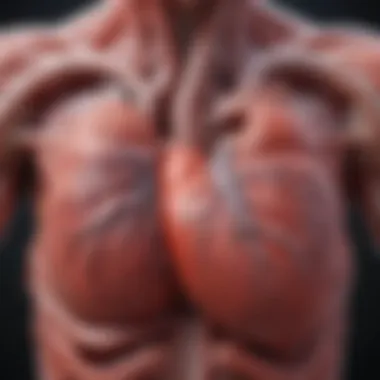
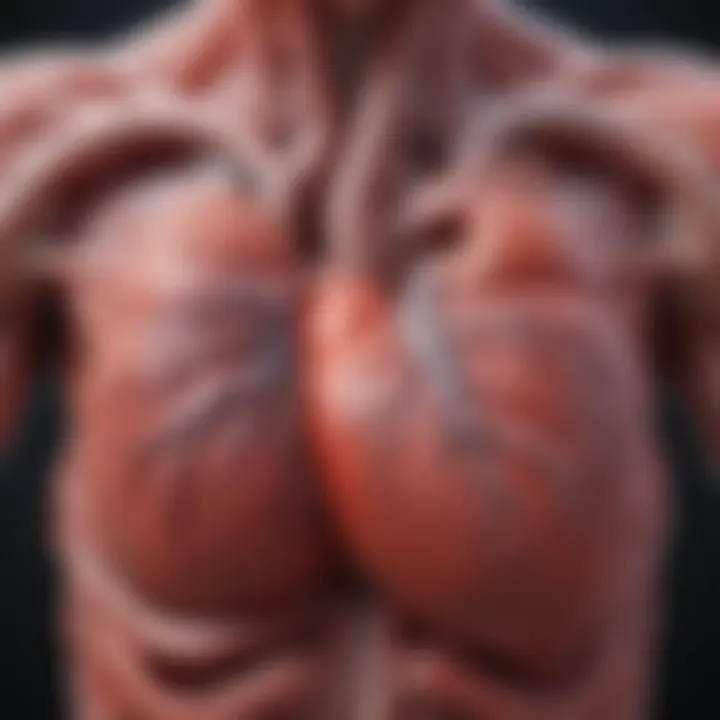
Intro
The relationship between heart function and breathing mechanics is profound and complex. This interplay plays a crucial role in maintaining homeostasis. Understanding this dynamic provides valuable insights into health, physical activity, and overall well-being.
Both the cardiovascular and respiratory systems are integral. They collaborate to meet the body's demands for oxygen and the removal of carbon dioxide. Any disruptions in this harmony can lead to significant health issues, making it vital to explore the mechanisms involved.
Research Overview
Summary of Key Findings
Research has shown that the heart and lungs do not operate independently. They influence each other seamlessly. Key findings from various studies suggest:
- The heart rate can change in response to breathing patterns. This phenomenon is known as respiratory sinus arrhythmia.
- Deep and controlled breathing can enhance heart function, improving cardiovascular health.
- Conditions like anxiety and stress affect both heart function and respiratory mechanics adversely.
This summary underscores the necessity of understanding how these systems work together and affect one another.
Relevance to Current Scientific Discussions
Current scientific discussions emphasize the integration of these two systems in various fields such as physiology, medicine, and health sciences. Researchers are exploring how therapies targeting one system can benefit the other.
For example, managing stress with controlled breathing techniques has implications for heart health. Furthermore, understanding this interplay is critical in treating conditions like chronic obstructive pulmonary disease and heart failure. It boosts our comprehension of overall health maintenance strategies and their effectiveness.
Methodology
Research Design and Approach
The studies analyzed are mainly observational and experimental, utilizing longitudinal designs to track changes over time. They often involve diverse populations to encompass various age groups and health statuses. This broad approach allows for a comprehensive understanding of the interplay between heart function and breathing mechanics.
Data Collection and Analysis Techniques
Data is collected through various methods, including:
- Clinical assessments measuring heart rate variability.
- Pulmonary function tests evaluating respiratory capacity.
- Self-reported questionnaires assessing psychological factors.
Statistical analysis methods, such as regression analysis, help researchers interpret the relationship and significance between these variables.
This research lays groundwork for future studies aimed at uncovering deeper insights into cardiovascular and respiratory collaboration.
Prelims to Heart and Breathing
The relationship between heart function and breathing mechanics is essential for maintaining our overall health. Both systems work in concert to ensure that oxygen reaches our body's tissues while removing carbon dioxide—a process vital for cellular function. Understanding this interplay can provide insights into various physiological processes and their implications for health and disease.
From a physiological perspective, the heart and lungs are closely linked. The heart pumps oxygenated blood from the lungs to the rest of the body, while also returning deoxygenated blood to the lungs for rejuvenation. This cycle is crucial for homeostasis, as it helps regulate not just oxygen levels, but also acid-base balance and metabolic processes.
Moreover, the mechanics of breathing influence heart rate and rhythm. For instance, slow, deep breaths typically reduce heart rates, while rapid, shallow breathing can increase them. This connection exemplifies the reflexive nature of these systems, where changes in one can directly affect the other.
Key Benefits and Considerations
- Holistic Understanding: Grasping how these systems affect each other can lead to better health awareness.
- Clinical Relevance: Knowledge about the cardiopulmonary connection can enhance clinical interventions for patients with heart or lung diseases.
- Physical Activity: Recognizing the interplay during exercise can improve performance and recovery strategies.
- Stress Management: Awareness of how breathing techniques can influence heart function offers opportunities for better stress management.
Understanding the dynamics between heart function and breathing provides a comprehensive framework for evaluating various health conditions. It helps in recognizing the importance of integrating strategies that consider both respiratory and cardiovascular health. Consequently, this introduction sets the groundwork for exploring more detailed aspects of their interactions in the sections that follow.
The Anatomy of the Heart
Understanding the anatomy of the heart is crucial for grasping how it collaborates with the respiratory system. The heart's structural framework underpins its function, influencing how effectively it pumps blood and responds to the demands of breathing. This section outlines its primary components, emphasizing their roles in maintaining cardiovascular and respiratory health.
Chambers of the Heart
The heart consists of four chambers: the right atrium, right ventricle, left atrium, and left ventricle. This separation is essential for efficient blood circulation. The right atrium receives deoxygenated blood from the body through the superior and inferior vena cavae. Subsequently, this blood flows into the right ventricle, which pumps it to the lungs via the pulmonary artery for oxygenation.
Conversely, oxygen-rich blood returns from the lungs to the left atrium via the pulmonary veins. It then moves into the left ventricle, the strongest chamber, propelling blood throughout the body via the aorta. This cyclic pattern ensures that oxygenated and deoxygenated blood do not mix, which is vital for the body’s overall energy levels and metabolic processes.
Valves and Blood Flow
Valves play a pivotal role in regulating blood flow within the heart. There are four main valves: the tricuspid valve, pulmonary valve, mitral valve, and aortic valve. These valves ensure unidirectional blood flow, preventing backflow during the contraction and relaxation phases of the heart.
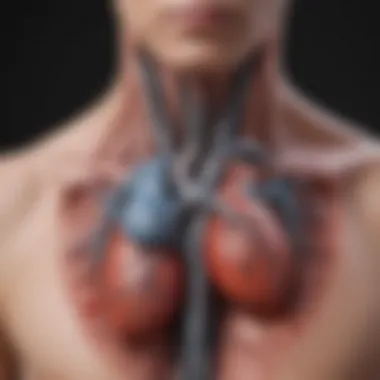
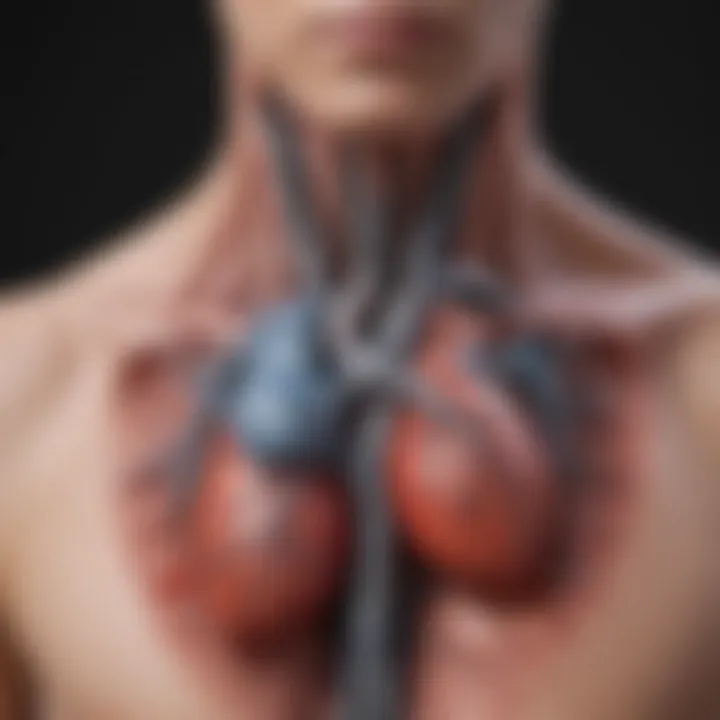
For example, the tricuspid valve opens to allow blood from the right atrium to flow into the right ventricle but closes when the ventricle contracts to push blood into the lungs. Similarly, the mitral valve operates in the left side of the heart, managing the flow of blood from the left atrium to the left ventricle. Dysfunction in any of these valves can lead to serious health issues including heart murmurs and heart failure.
Electrical Conduction System
The heart’s ability to contract and pump effectively is governed by its electrical conduction system. This system consists of specialized cardiac cells that generate electrical impulses, coordinating heartbeats. The sinoatrial (SA) node, located in the right atrium, acts as the primary pacemaker of the heart.
When the SA node fires, it sends an impulse that prompts the atria to contract, pushing blood into the ventricles. This impulse travels to the atrioventricular (AV) node, where it brief pauses to allow the ventricles to fill before stimulating them to contract. This intricate timing is essential for optimal heart function, influencing not just the pace but also the harmony between heart activity and breathing.
The precise orchestration between the heart's electrical conduction and the physical chambers is key to effective blood and oxygen delivery throughout the body.
In summary, understanding the anatomy of the heart reveals its complex yet organized structure, each part working in concert. This knowledge is foundational for appreciating how the heart interacts with the respiratory system, ultimately impacting overall health.
The Mechanics of Breathing
Breathing is a fundamental process in human physiology. It involves two primary actions: inhalation and exhalation. Understanding the mechanics of breathing is crucial, as it not only affects oxygen intake but also plays a significant role in maintaining heart function. This section will discuss the anatomy of the respiratory system, the phases of breathing, and the processes of gas exchange. Each of these elements highlights the interconnectedness between breathing and cardiovascular health.
Anatomy of the Respiratory System
The respiratory system consists of various organs and structures that facilitate the exchange of gases. Major components include the nasal cavity, trachea, bronchi, lungs, and alveoli. The nasal cavity warms and humidifies the air entering the body. The trachea is a tube that conducts airflow into the lungs. Bronchi branch off from the trachea and lead to the lungs, which house the alveoli, the tiny air sacs where gas exchange occurs.
Each part of this system plays a role in ensuring that oxygen is supplied to the body while removing carbon dioxide. The mechanics of breathing rely heavily on the diaphragm, a dome-shaped muscle beneath the lungs. When the diaphragm contracts, it flattens, creating negative pressure that draws air into the lungs. This intricate design allows for efficient gas exchange and supports overall heart function.
Phases of Breathing
Breathing occurs in two distinct phases: inspiration and expiration. During inspiration, air is drawn into the lungs. This phase starts with the contraction of the diaphragm and intercostal muscles, expanding the thoracic cavity. The increased volume lowers the pressure in the lungs, enabling air to flow in. The duration of inhalation can be influenced by various factors, including physical activity and emotional state.
In expiration, the diaphragm relaxes, and the chest cavity volume decreases. This phase can be passive or active depending on the context. In normal, quiet breathing, expiration is passive, resulting from elastic recoil of the lungs. However, during vigorous exercise, expiration can become an active process, engaging additional muscles to expel air more forcefully. The efficiency of these phases has crucial implications for heart function, particularly in oxygenating blood efficiently.
Gas Exchange Processes
Gas exchange is the vital process by which oxygen enters the bloodstream and carbon dioxide is removed. It occurs within the alveoli, where oxygen from inhaled air passes into the blood. Conversely, carbon dioxide, which is produced as a waste product of metabolism, diffuses from the blood into the alveoli for exhalation.
Several factors influence the efficiency of gas exchange, including:
- Surface Area: The more alveoli available, the greater the potential for gas exchange.
- Membrane Thickness: A thinner membrane allows for quicker gas diffusion.
- Partial Pressure Gradients: The difference in gas concentrations drives diffusion; oxygen must be higher in the alveoli than in the blood.
Understanding how these processes work together is essential for grasping the heart-breathing interplay. Optimal gas exchange contributes to effective oxygen delivery to the heart, supporting its vital functions.
"A better understanding of the mechanics of breathing enhances our grasp on how respiration impacts cardiovascular health."
In summary, the mechanics of breathing encompass a complex interplay of anatomical structures and physiological processes. Knowledge of these mechanisms helps clarify how heart function depends on efficient breathing, laying the groundwork for further exploration of cardiopulmonary interactions.
Physiological Interactions Between Heart and Breathing
The relationship between heart function and breathing mechanics is a critical area of study in physiology. Understanding how these two systems interact is essential for health professionals and researchers, as this knowledge can help in identifying ways to improve patient care and overall health outcomes. The heart and lungs work together to ensure that oxygen-rich blood circulates throughout the body while removing carbon dioxide efficiently. This synergistic relationship is vital for maintaining homeostasis, especially during physical activities and varying emotional states.
Cardiopulmonary Interactions
Cardiopulmonary interactions refer to how the heart and lungs influence each other during their operations. When one system functions optimally, the other typically follows suit, resulting in a stable physiological state. For example, during exercise, the body requires increased oxygen delivery and carbon dioxide removal. In response, the heart rate increases, pumping blood more rapidly to supply oxygen, while the respiratory rate also elevates to enhance gas exchange in the lungs. This dynamic coordination is governed by complex neural and chemical regulatory mechanisms that respond to the body’s demands in real-time.
Impact of Breathing on Heart Rate
Breathing directly impacts heart rate through a phenomenon known as respiratory sinus arrhythmia. This condition describes the fluctuations in heart rate that occur during the breathing cycle.
When a person inhales, heart rate tends to increase due to the influx of air and subsequent expansion of the chest cavity. Conversely, during exhalation, heart rate often decreases as the body returns to a resting state. This interplay is not merely a coincidence but is crucial for optimizing circulatory efficiency and ensuring adequate oxygenation of the blood. Moreover, different breathing techniques can lead to distinct effects on heart rate, influencing physical and mental health.
The Role of Chemoceptors
Chemoceptors play a fundamental role in regulating the physiological interactions between the heart and breathing. These specialized sensory receptors are located in various parts of the body, including blood vessels and the brain. They detect changes in levels of carbon dioxide, oxygen, and pH in the blood. When these levels are altered—such as during exercise or in response to stress—chemoceptors send signals to the brain, prompting the autonomic nervous system to make necessary adjustments in heart rate and respiratory rate.
Understanding this system's functioning can help in developing targeted therapies for individuals suffering from respiratory and cardiac pathologies. For instance, patients with chronic obstructive pulmonary disease may benefit from interventions that enhance chemoceptor sensitivity, thus improving their heart function and overall quality of life.
"The seamless interaction between the heart and lungs demonstrates the importance of integrated physiological responses in maintaining health and homeostasis."
The Influence of Physical Activity

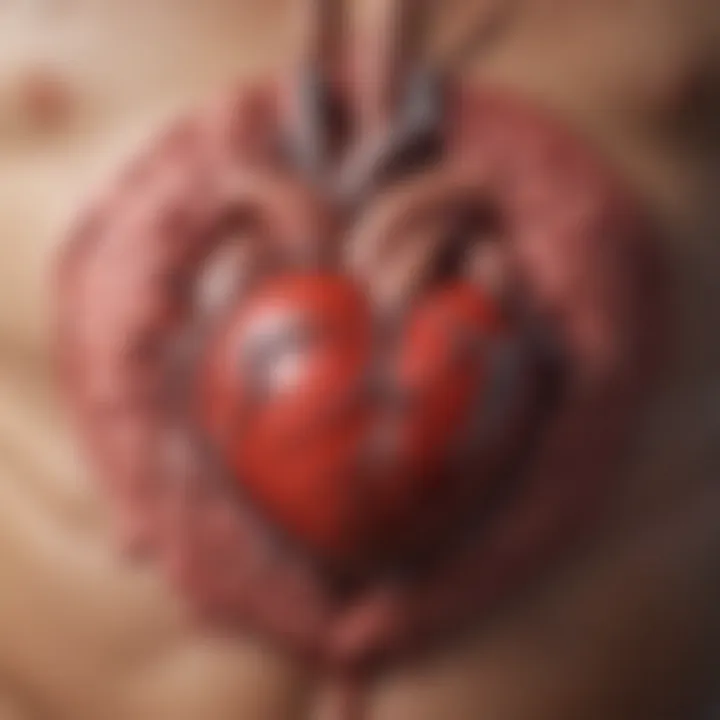
Physical activity plays a crucial role in the intricate relationship between heart function and breathing mechanics. Engaging in regular exercise not only enhances cardiovascular health but also optimizes respiratory function. The interplay between the two systems becomes particularly evident during physical exertion. When the body is active, the demand for oxygen increases, prompting the heart and lungs to work in concert to meet this need.
Heart Rate Variability During Exercise
Heart rate variability (HRV) refers to the variation in time between each heartbeat. It is a key indicator of autonomic nervous system activity and cardiovascular efficiency. During exercise, HRV typically decreases due to the activation of the sympathetic nervous system. This response prepares the body for increased physical demands. A more robust HRV can indicate higher cardiovascular fitness and overall health.
Maintaining a higher heart rate variability is associated with better health outcomes and improved athletic performance.
Understanding how HRV reacts to different types of exercise, such as endurance versus high-intensity training, can offer insights into an individual's fitness level and cardiovascular responsiveness.
Respiratory Rate Changes During Activity
When a person engages in physical activity, respiratory rate increases to facilitate enhanced oxygen intake. This adaptation is crucial because it ensures that oxygen supply meets the heightened demand during exercise. The intensity of physical activity can directly influence the rate and depth of breathing. For example, during vigorous exercise, individuals may experience rapid, shallow breaths, whereas moderate activity might result in slower, deeper breaths.
Factors such as fitness level also affect respiratory rate responses. Well-trained athletes may demonstrate more efficient breathing patterns compared to sedentary individuals.
Cardiovascular Fitness and Respiratory Health
Cardiovascular fitness is not merely a measure of heart function; it inherently ties into respiratory health. Higher levels of fitness improve lung capacity and efficiency, allowing for better oxygenation of blood and removal of carbon dioxide. Regular aerobic exercise can lead to adaptations in both the heart and lungs. These adaptations enhance blood flow and support optimal gas exchange during breathing.
Moreover, aerobic conditioning can reduce the risk of developing respiratory conditions, thereby improving overall health.
In summary, the interplay of heart function and breathing mechanics during physical activity showcases how both systems collaborate to support bodily demands. Improving cardiovascular fitness through regular exercise not only strengthens the heart but also optimizes breathing, leading to better overall health.
Impact of Psychological Factors
The psychological well-being of an individual plays an integral role in the function of both the heart and breathing mechanics. Understanding how emotional states influence these physiological systems is essential for a holistic view of health. Stress, anxiety, and emotional disturbances can have profound impacts on cardiovascular health and respiratory function.
Effects of Stress on Heart Function
Stress is often seen as a daily part of life, but its effects on heart function are significant. Under stress, the body releases hormones such as adrenaline and cortisol. These hormones prepare the body for a 'fight or flight' response, increasing heart rate and blood pressure. This response can lead to chronic conditions if stress is not managed effectively.
Conditions such as hypertension and even heart disease can arise from prolonged stress. Researchers have found that high levels of psychological stress can lead to inflammation and damage to the blood vessels, contributing to atherosclerosis, a major risk factor for heart attacks.
"Effective stress management can lead to significant improvements in heart health."
Breathing Techniques for Stress Management
Breathing techniques are powerful tools in managing stress. They facilitate better oxygenation of the body and can directly influence the heart rate. Techniques such as diaphragmatic breathing, box breathing, and the 4-7-8 technique promote relaxation by activating the parasympathetic nervous system. This response counteracts the stress-induced sympathetic nervous system activation.
Implementing these techniques can:
- Decrease heart rate
- Reduce feelings of anxiety
- Improve overall emotional well-being
Regular practice can lead to long-term benefits, enhancing both respiratory efficiency and cardiovascular health.
Mindfulness and Its Effects on Heart Rate
Mindfulness practices, such as meditation and yoga, are effective in lowering heart rates and improving overall cardiovascular function. The focus on present-moment awareness helps reduce stress levels. This, in turn, affects heart function positively.
Research indicates that individuals who practice mindfulness techniques regularly report lower resting heart rates and improved heart rate variability, a key indicator of heart health. Mindfulness reduces emotional reactivity, allowing for a more stable cardiovascular profile.
In summary, psychological factors intertwine closely with heart and breathing function. Addressing stress through effective techniques can lead to better health outcomes, clearly showing the need for an integrated approach to mental and physical wellness.
Pathological Conditions Affecting Heart and Breathing
The interplay between heart function and breathing can be significantly disturbed by various pathological conditions. Understanding these conditions is crucial as they affect not just individual health but also the broader functionality of interconnected cardiovascular and respiratory systems. The significance of exploring pathological influences lies in identifying how these diseases can disrupt normal physiology, potentially leading to severe health consequences.
Heart Diseases and Their Impact on Respiration
Heart diseases, such as coronary artery disease and heart failure, can drastically affect respiratory function. The heart provides essential blood flow to the lungs. When the heart's efficiency declines, blood flow may become inadequate. This can result in pulmonary congestion, where fluid accumulates in the lungs, impairing gas exchange. Symptoms like shortness of breath may arise, reflecting the heart's compromised ability to support the respiratory system effectively.
- Coronary Artery Disease: Narrowing of the arteries limits oxygen and nutrients to heart muscle, causing strain.
- Congestive Heart Failure: When the heart cannot pump effectively, it can cause pulmonary edema.
- Arrhythmias: Irregular heartbeats can lead to ineffective blood flow, impacting breathing.
These conditions necessitate a multidisciplinary approach for management. Coordination between cardiologists and pulmonologists is essential for optimized patient outcomes.
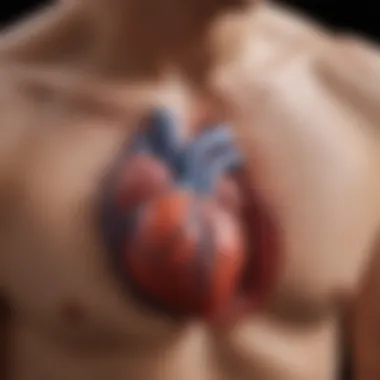
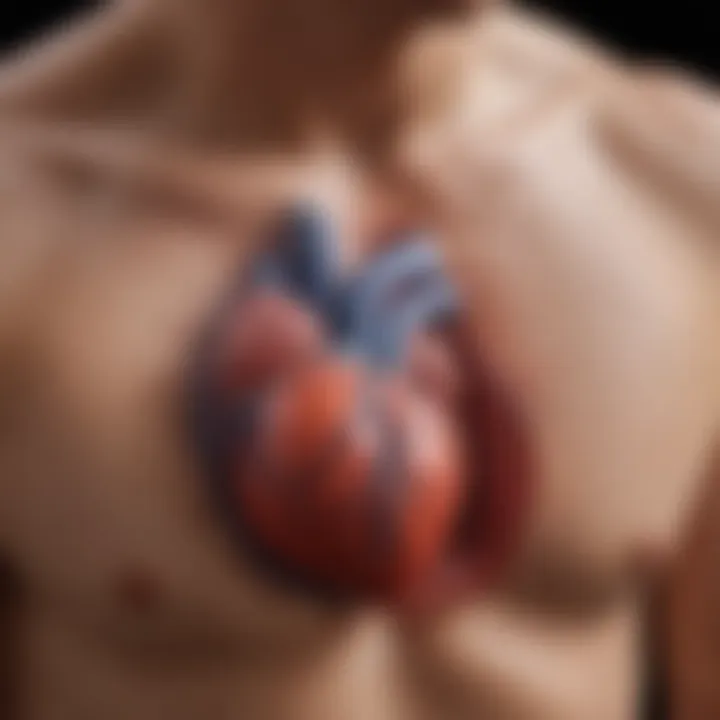
Respiratory Disorders and Cardiac Response
Respiratory disorders, such as chronic obstructive pulmonary disease (COPD) and asthma, can also evoke specific cardiac responses. When the lungs cannot efficiently exchange carbon dioxide and oxygen, it places stress on the heart. This is especially pronounced in COPD, where chronic low oxygen levels can lead to increased pulmonary artery pressure, potentially causing right heart failure or cor pulmonale.
Patients suffering from these respiratory issues often display:
- Increased heart rate.
- Elevated blood pressure.
- Changes in heart rhythm.
The physiological stress induced by these disorders highlights the need for careful management of both respiratory and cardiac symptoms.
Sleep Apnea and Cardiovascular Health
Sleep apnea is a serious condition characterized by repeated interruptions in breathing during sleep. This can lead to decreased oxygen levels in the blood and increased blood pressure. In the long term, untreated sleep apnea can result in significant cardiovascular problems, such as hypertension, atrial fibrillation, and even stroke.
The relationship between sleep apnea and cardiovascular health underscores the importance of timely diagnosis and treatment. Effective management of sleep apnea can lead to improvements in both heart function and respiratory health.
In summary, the interactions between heart diseases, respiratory disorders, and conditions like sleep apnea illuminate intricate physiological relationships that are vital for health care professionals to recognize. Monitoring and managing these pathological conditions can improve outcomes and enhance quality of life.
The Role of Healthcare in Monitoring Heart and Breathing
The relationship between heart function and breathing is complex and vital for overall health. Healthcare plays a significant role in monitoring these systems to ensure optimal bodily function. Early detection of any changes in heart or respiratory functions can lead to timely intervention and prevention of severe complications. Health professionals utilize various techniques to assess and monitor the interplay between these systems.
Diagnostic Imaging Techniques
Diagnostic imaging is crucial for evaluating heart and lung conditions. Technologies such as echocardiography, chest X-rays, and MRI scans provide detailed insights into the structure and function of the heart and lungs.
- Echocardiography allows for the visualization of heart chambers and valves, helping to identify structural abnormalities that may affect circulation and breathing.
- Chest X-rays offer a quick overview of the lungs and heart, aiding in the detection of fluid buildup or enlargement of either organ.
- MRI scans provide high-resolution images, useful in assessing complex cases and aiding in treatment planning.
These techniques not only diagnose existing issues but help monitor ongoing conditions, allowing for adjustments in treatment plans.
Cardiorespiratory Monitoring Devices
In modern healthcare, cardiorespiratory monitoring devices are vital. These devices continuously track heart rate, respiratory rate, and oxygen saturation. The data gathered is essential for both diagnosis and treatment monitoring. Technologies such as Holter monitors and pulse oximeters play significant roles.
- Holter monitors are worn by patients for 24 hours or longer, recording heart activity. This information helps in understanding heart function during various activities including sleep.
- Pulse oximeters non-invasively measure the oxygen level in the blood, providing real-time data on respiratory efficiency.
- Capnometers measure the concentration of carbon dioxide in exhaled air, which gives insights into metabolic and respiratory function.
These devices support health professionals in dynamically assessing patient health, enabling timely medical actions.
Interventional Procedures
Intervention strategies may be required when diagnostics and monitoring indicate serious issues with heart and breathing function. Various interventional procedures exist that can help restore normal function or address underlying problems.
- Cardiac Catheterization allows for direct measurement of pressures in the heart and provides opportunities for intervention, such as balloon angioplasty or stent placement.
- Bronchoscopy enables direct visualization of the airway and lungs, allowing for interventions such as removing obstructions or taking biopsies.
- CPAP therapy can be initiated in patients with sleep apnea, improving breathing mechanics during sleep, which subsequently benefits cardiovascular health.
Healthcare’s role is not just reactive but proactive in managing health by continuously monitoring and, when necessary, intervening to maintain the delicate balance between heart function and breathing. Ultimately, effective monitoring leads to improved patient outcomes and quality of life.
Effective monitoring and timely intervention are essential in preserving the intricate balance of physiological function between the heart and lungs.
The End and Future Directions
The relationship between heart function and breathing mechanics is pivotal in understanding overall health. This intersection highlights how these two systems work together to maintain homeostasis. Practical implications arise from this relationship, particularly in clinical settings, where knowledge of both cardiovascular and respiratory health is crucial.
Understanding the mechanisms through which these systems interact can lead to better diagnostic tools and treatment plans. For instance, disorder in one system often indicates potential issues in the other. Therefore, having a comprehensive understanding can assist healthcare providers in early detection and intervention strategies, improving patient outcomes significantly.
Summary of Key Findings
Several key points emerge from this exploration:
- Interconnectedness: The heart and lungs operate collaboratively. Changes in breathing can affect heart rate and vice versa.
- Physiological Adaptations: Both systems adapt during physical activity, enhancing overall performance and fitness. Increased demand for oxygen leads to a compensatory increase in heart rate.
- Pathological Impacts: Conditions like sleep apnea demonstrate how a dysfunction in one system can severely impact the other, leading to grave health risks.
- Psychological Influences: Stress significantly affects heart function and breathing patterns, highlighting the need to address mental health as part of physical health strategies.
Potential Areas for Further Research
Future studies could delve into various aspects that may enhance our comprehension of heart-breath interactions:
- Investigating Chronic Conditions: More research on how chronic respiratory and cardiac diseases impact each other over time could provide valuable insights for patient care.
- Breathing Techniques: Understanding how different breathing techniques can mitigate stress and improve heart health is a promising field.
- Technology Integration: The development of monitoring devices that can simultaneously track heart and respiratory function may yield new insights into patient conditions.
- Population Studies: Analyzing large populations to identify trends between breathing patterns and heart health could inform preventative measure designs.
The Importance of Integrating Health Approaches
Integrating an approach that considers both heart and breathing health is essential. Healthcare professionals should emphasize the need for holistic treatment plans. Combined strategies may include:
- Lifestyle Modifications: Encouraging exercises that improve both cardiovascular fitness and respiratory health.
- Educational Programs: Raising awareness about how emotional well-being affects physical health can empower patients.
- Preventative Screening: A collaborative approach promoting regular check-ups for both heart and lung health can lead to early interventions.



